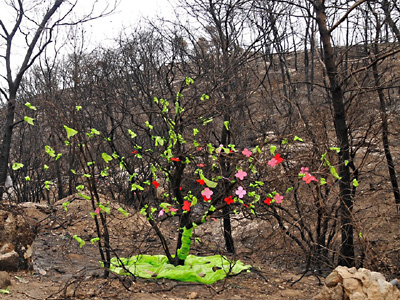We're not cutting many trees down yet, even if they're burned, because their roots help prevent soil erosion." We were speaking with Dr. Omri Bonneh, KKL-JNF Northern Region Director, about KKL-JNF's rehabilitation program for the Carmel Forest after the devastating forest fire that destroyed 35,000 dunams of natural woodlands and planted forest. The cost of rehabilitation is estimated at hundreds of millions of shekels.
"In general, our policy is to let nature take its course, but there's still a huge amount of work to do. For example, when new trees sprout, we have to do a lot of thinning in order to lessen competition between the trees. Due to global warming, there's been a drop in the amount of annual rainfall, so there's less water to go around, and a tree needs more space in order to survive. Selective thinning increases biodiversity. Natural selection favors pines, which are the quickest to grow, but we are interested in forests with a wide variety of trees.
"There are, however, places where we will be planting new trees in the spring. Young forests don't have a large seed pool, so when they burn down, we need to help nature by planting trees.
"Lots of people, both from Israel and also from abroad, have volunteered to help us rehabilitate the Carmel. In a few weeks, we'll begin working in the areas bordering on the burnt forests, where we'll be thinning, pruning and creating new fire breaks. This needs to be done in order to protect the unburned forests from future fires. We also need to remove wood residue and tree branches from the forest floor to be better prepared for future fires, so there is definitely lots of work for volunteers.
"In terms of what we need to do right now, there is a real and immediate need that most people are not aware of. The areas burned in the Carmel forest were one of Israel's major outdoors activities centers, and we need to immediately begin developing alternative recreation corners, scenic roads, hiking trails and biking trails, to mention just a few. In order to be able to accomplish this, we are counting on contributions from friends of KKL-JNF throughout the world.
"There is another pretty much unpublicized aspect of our forest rehabilitation program. One of the things we learned after the Second Lebanese War was that rehabilitation isn't just about nature; it should include the communities that live near the forest. For example, KKL-JNF involved the communities of Tzefat and Hatzor Haglilit in rehabilitation activities after the war. Together, we created what we call 'community based forests,' which means that local residents adopt forests adjacent to their homes, help take care of them and become part of the decision-making process. We will be meeting with the people of Ein Hod, Ussafiya, Nir Etzyon, Beit Oren and Yemin Orde and talking with them about strengthening their bond to the forest that’s being rehabilitated, environmental education and other ecological topics. The Carmel Forests are defined as a biosphere reserve, which means that everyone who lives in the area works together to find solutions that take the interests of all the biosphere components into consideration.
"At KKL-JNF, we feel confidant that we are up to the job of rehabilitating and restoring the Carmel Forest, a task we hope to accomplish with the support of the many people all over the world who have expressed their desire to help."
Click for the flowers of the Carmel
